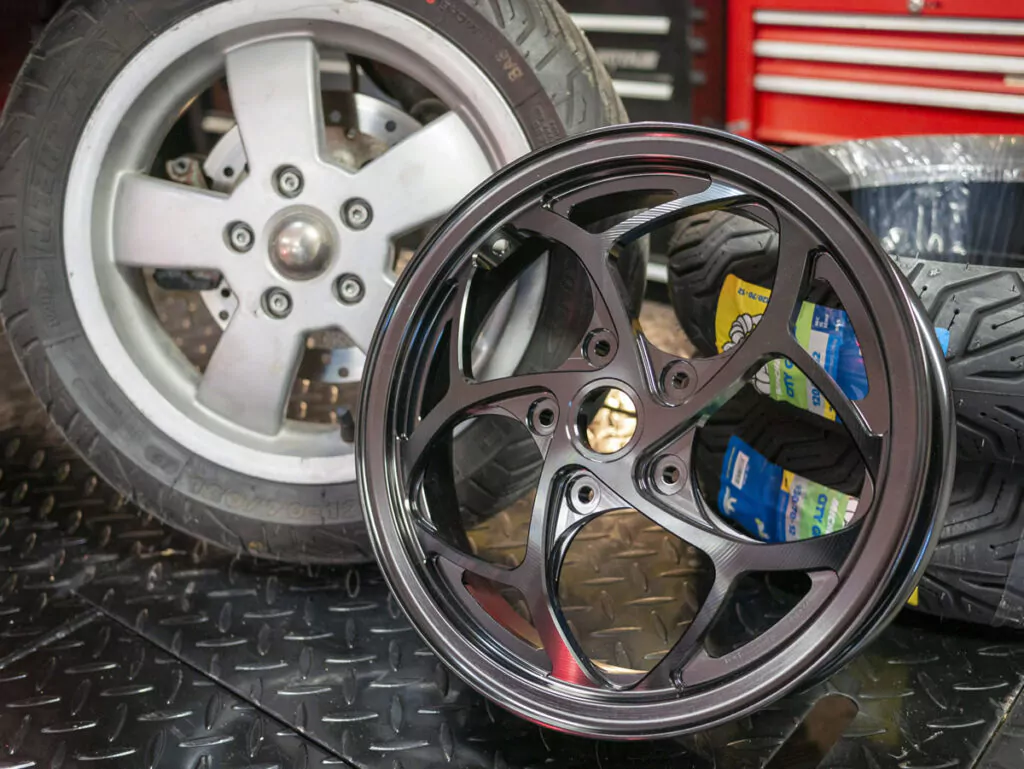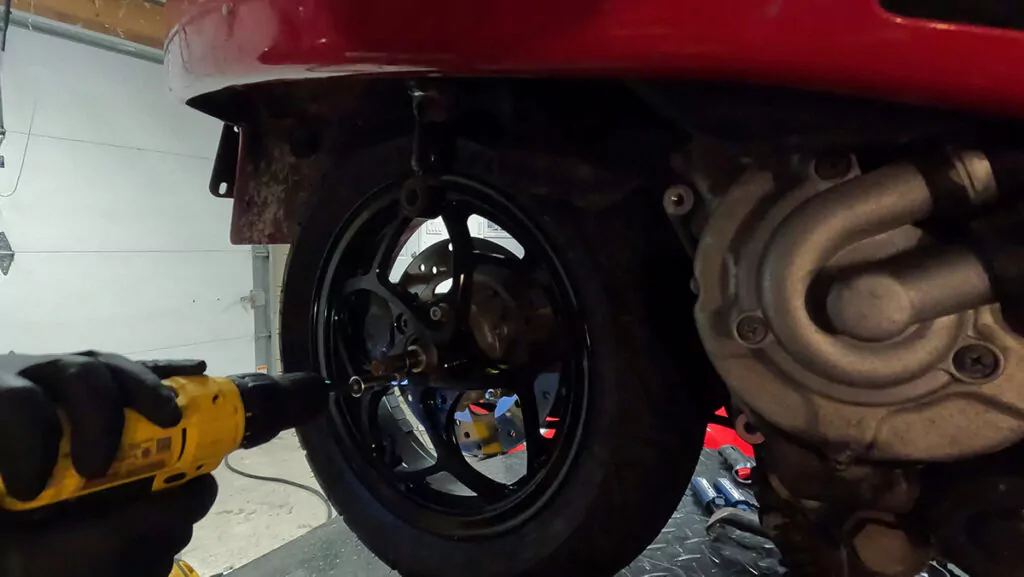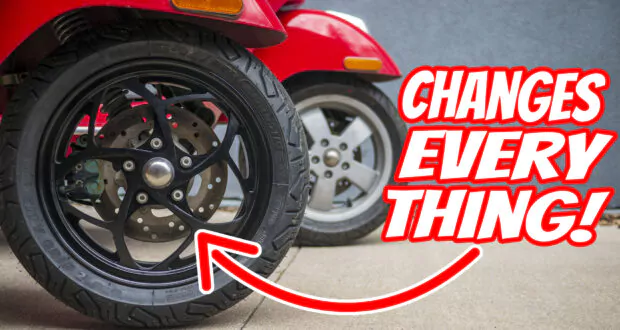Forged motorcycle wheels can give your motorcycle improved performance in the areas of acceleration, handling, braking power, and ride quality. We’ll review the MOS Motor forged wheels to explore the key differences between forged and cast wheels, and whether or not investing in forged wheels can significantly impact your overall riding experience.
Based on the insights shared in the video by Adrian from YouMotorcycle, we’ll delve deeper into how both forged and cast motorcycle wheels are made differently, and how these differences impact real-world performance testing to see if these rims live up to the hype.


Understanding Casting and Forging Processes
Before we dive into the benefits of forged motorcycle wheels, it’s essential to understand the fundamental differences between casting and forging processes.
Cast wheels are manufactured by pouring heated aluminum into pre-made molds. It’s like making ginger bread cookies using cut-out shapes.
Forged wheels are made by shaping a chunk of aluminum through heating and hammering before cutting out the necessary notches. It’s like when you see a movie set in medieval times and you see a blacksmith hammering a sword into creation for the hero.
Weight and Strength
The distinction in manufacturing processes leads to varying characteristics and performance traits. When it comes to motorcycle wheels, weight and strength play crucial roles in determining performance.
Cast motorcycle wheels tend to be heavier compared to their forged counterparts. Cast wheels are heavier because they tend to use less strong aluminum alloys compared to forging. This can result in a denser metal structure and thicker sections, leading to increased weight.
Cast motorcycle wheels also tend to be weaker than forged wheels. During the casting process, the presence of bubbles and imperfections can create weak points, making cast wheels more susceptible to damage and bending.
In contrast, forged wheels offer superior strength and durability due to the absence of such imperfections. While the forging process requires more time and effort, the end result is a lighter and stronger wheel.
Unsprung Mass and Inertia
Unsprung mass refers to the components below your motorcycle’s suspension, such as wheels, brakes, and drivetrain parts. The weight of these components directly affects the motorcycle’s acceleration, handling, and ride quality. Forged motorcycle wheels are better than cast wheels for a number of reasons, mostly based around having less unsprung weight.
For example, lighter forged wheels are easier to get spinning , and easier to stop spinning, which means faster acceleration and better braking power. Lighter wheels also make road imperfections much less jarring, which makes ride quality smoother. Finally, lighter wheels spinning are also easier to lean from side to side, leading to increased handling capabilities.
Or at least, that’s what we’re lead to believe. It’s time to put all that theory to the test.

MOS Forged Wheels Real-world Performance and Feedback
Now that we understand the science behind forged wheels, what makes them different, and how they should improve our motorcycle, let’s put these MOS Motor forged wheels to the test. We’ll explore the quality of the fit and finish, installation, and most importantly, what the actual riding experience of a forged wheel vs a cast one is like and whether or not it lives up to expectations.
Fit and Finish
Personally, the MOS Motor forged wheels look really good to me. I have to admit I’m no expert though. So I brought the wheels to both Cyclewerx in Toronto, Canada, and to Moto Motori in Vaughan, to get their thoughts. Both shops had never seen a MOS product before and seemed to like what they saw.
Cyclewerx did the mounting while Moto Motori did the balancing, at that point, I brought the wheels home and did the installation.
Installation
Installation is typical of any other rim, in the example of the Vespa GTS you remove the exhaust, then the swingarm, then the wheel itself, install the new MOS Motor forged wheel, and put the swing arm and exhaust back on.
For the front tire you’ll want to have the Vespa on the center stand, then jack up the front end a bit, remove the five bolts holding the front wheel in place, remove the OEM wheel, install the forged wheel.
So how does it actually ride and can you actually feel a difference?

How We’ll Test the Forged Wheel
Because of how long it takes to change wheels on a Vespa, and the lack of me having a proper race track to really push limits and track my lap time, it’s going to be tricky to do some proper A-B testing on the forged wheels… Or at least that’s what I thought.
But then I remembered I could get an identical Vespa GTS 250, test both bikes with stock configurations, note any differences, and then only put the forged wheels on one.
MOS Motor Forged Motorcycle Wheel Testing Results
Acceleration – Acceleration had a noticeable improvement with the lighter weight forged wheels. Not huge, not substantial, but definitely noticeable. Rolling on the throttle, especially from a stop, felt like the engine wasn’t working as hard and picked up speed faster. It’s like I was getting more juice for the same amount of squeeze.
Road feel – On really smooth asphalt both bikes feel basically the same, but the extra friction from riding over rougher more coarse asphalt makes more vibration but because the forged wheels are lighter, they help your suspension work better, and on rougher terrain it definitely felt like a smoother more premium ride.
Braking – I didn’t test emergency braking because yes, each bike got new Michelin City Grip tires, but they have different brake wear on the pads, so I can’t really give you a fair comparison on that. All I can say is that we know from physics it takes less energy to stop a lighter wheel from spinning than a heavier one, so the forged wheels should give more stopping power and less stopping distance.
Handling – At first, I actually preferred the original cast wheels, then I set both bikes to the correct tire pressure, removing the top case because it adds weight above the center of gravity, and behind the bike’s rear axle, and broke in both sets of brand new Michelin City grip tires, and now, I kind of like the forged better, but honestly, at the kind of speeds I was doing, compared to the improvement in acceleration and ride quality, the difference is barely noticeable.
Conclusions
Cast motorcycle wheels are made very differently, and the difference in weight can have a big impact in how your motorcycle or scooter ride. At a minimum you’ll probably noticed improved acceleration and ride feel, but you may also notice braking and handling improvements as well.
 YouMotorcycle Motorcycle Blog – Motorcycle Lifestyle Blog, MotoVlog, Motorcycle Reviews, News, & How-Tos
YouMotorcycle Motorcycle Blog – Motorcycle Lifestyle Blog, MotoVlog, Motorcycle Reviews, News, & How-Tos

Thanks for shining some light on unsprung weight woes. Whenever I see wheels growing larger on SUVs every year I can’t help but think people are getting more and more oblivious. Have we lost touch with basic physics, or is it all about the aesthetics? Your insights are golden, keep ’em coming!
Another gem of a video, man, schooling us on the ins and outs of our beloved motorcycles. Appreciate the knowledge drop! Thanks Dan